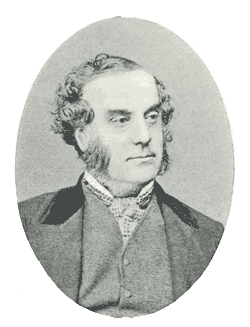"There lies a vessel in that realm of frost,
Not wrecked, not stranded, yet for ever lost;
Morn shall return, and noon, and eve, and night,
Meet here with interchanging shade and light;
But from that barque no timber shall decay,
Of those cold forms, no feature pass away;
Perennial ice around th' encrusted bow,
The empty deck, and shatter'd masts shall grow,
Till from the sun himself the whole be hid,
Or spied beneath a crystal pyramid'
Few times so few words could have described better the tragedy happened in the Arctic, and so few words could have better described the present situation on which the Terror is eluding the attempts of the Canadian government to find it. It looks like as if the poem had predicted that any shipwreck would ever be found.
Those, are the words which accompanied the working model over which the Francis Rawdon Moira Croizer statue in Banbridge was based.
 |
Colossal Statue of the late Captain Crozier, RN
| http://archiseek.com/2014/1862-crozier-memorial-banbridge-co/ |
It was the same sculptor, Joseph Robinson Kirk, who made both statues, the marble model and the statue which is guarding Crozier´s house in Banbridge. The author of these words, as Randall Osczevsky indicated me, seems to come, or better said: based, from the poem called Greenland by James Montgomery. The poem is much larger and it looks as if some phrases would have been selected to fit in some sort of plaque or engraving in the Kirk´s marble model.
Kirk´s work didn´t end here, he also made a bust of Francis Leopold McClintock whose location is unknown to me and the marble Crozier memorial of Seapatrick church, which Regina Koellner indicated me was also made by him. The memorial it is described here as follows:
 |
| Joseph Robinson Kirk, R.H.A. Photograph. http://www.libraryireland.com/irishartists/joseph-robinson-kirk.php |
"The two small panel carvings in the niches, with the larger Crozier Memorial (also by J.R. Kirk) in Seapatrick Church, are of considerable merit. All display the Erebus and Terror (the ships of the expedition) starkly embedded in great chunky three-dimensional ice-floes, exciting and near-abstract triumphs of the imagination, as weird and poetic as the rockery mountains invented by Joachim Patinir, and for the same reason: neither artist had ever seen what he sought with such intensity to portray."
 |
| Crozier´s memorial in Seapatrick Church, Banbridge http://freespace.virgin.net/mp.hearth/Banbridge_Crozier.jpeg |
Our people in the field, Regina Koellner, Kat Stoetzel and William Greenwell, are doing some researching in Banbridge area right now. Regina has allowed me to show a better picture of the Crozier´s memorial in Seapatrick church:
To me, Montgomery´s poem, or its arrangement, is like a premonitory dream. The selection of phrases and words could have hardly been better chosen. However, no matter what the poem says the truth is that:
 |
| Crozier´s memorial in Seapatrick Church, Banbridge Photo by Regina Koellner. |
The Terror will be sooner than later found, it won´t be forever lost
Not stranded, that for sure, but shipwrecked and covered of moss,
No decayed timber will be found, cold waters will preserve them for us,
But her forms will indeed have passed away , about that you can trust
Her empty decks must be found, that is true, but broken and rust
Her shattered masts won´t grow again, they are not longer holden to the ship fast

Hellooo, Andres! It's so nice to visit your blog again and see all of your insightful, carefully crafted posts! I like how you started this one with an excerpt from Montgomery's eloquent poem; I have never heard it before, and my interest is definitely piqued! The monuments are gorgeous, and it's nice to see that Regina supplied a photo! Your clever twist on the poem sums it up nicely: the Terror will be found (let's hope it occurs within our lifetimes).
ResponderEliminarHi Jaeschylus! It is wonderful to reading you here again! Thanks for your kind words. I think that finding the Terror it is only a matter of time. And my guts say that they will find it not too late!!
ResponderEliminar